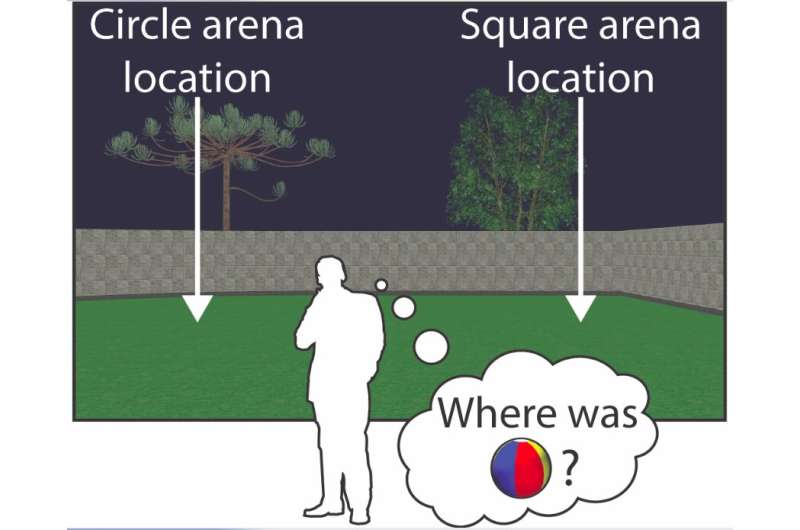May 12, 2021 feature
Remapping and realignment in the hippocampal formation predict context-dependent spatial behavior

Past neuroscience research has consistently highlighted the role of the hippocampal formation in contextual memory, the ability to remember specific contexts or environments. In this brain area, context is typically represented by the activity of a specific neuronal population, known as "place cells." As their name suggests, place cells fire whenever a human or animal is in specific places, environments or locations.
Researchers at the Kavli Institute for Systems Neuroscience, part of the Norwegian University of Science and Technology, have recently carried out a study investigating how two processes in the hippocampal formation, known as remapping and realignment, contribute to context-dependent spatial behavior in humans. Their paper, published in Nature Neuroscience, provides new insight about the neural underpinnings of contextual memory functions that can be impaired in individuals with specific brain disorders, such as Alzheimer's disease.
"Different place cells fire in different locations, and thus—as a population—reflect a cognitive map of the local context," Joshua B. Julian, one of the researchers who carried out the study, told Medical Xpress. "Beyond distinguishing between locations within a context, the hippocampus also stores multiple maps that allows it to represent multiple contexts through a process known as remapping."
Remapping in the hippocampal formation is typically accompanied by a shift in the firing patterns of grid cells within the entorhinal cortex (EC). This process, known as grid realignment, also contributes to contextual memory, as grid cells are known to fire whenever humans occupy a hexagonal lattice of positions in their surrounding environment, providing a metric for the cognitive map created by place cells.
"Our catalyzing question was simple: If the hippocampal formation mediates contextual memory, as many theories of hippocampal function presuppose, one would expect that there are links between hippocampal remapping, entorhinal grid realignment and context-dependent behavior," Julian said. "Despite decades of research on the role of the hippocampal formation in memory, it was unclear if changes in hippocampal remapping and grid realignment are related to detectable changes in context-dependent behavior during spatial memory tasks."
To test the relationship between neural activity in the hippocampal formation and contextual memory functions, Julian and his colleague Christian F. Doeller created a new navigation behavioral task accessible via virtual reality (VR) technology. As part of this task, human participants first learn the positions of objects in two VR arenas, one with a square boundary and the other with a circular boundary. Subsequently, the researchers tested their contextual memory while they gathered images of their brain using functional magnetic resonance imaging (fMRI) technology.
"Since the identities of the target objects were the same in the two arenas, to solve this task, participants needed to decide where to go based on the target object they were instructed to find on each trial and the arena they occupied," Julian said. "During fMRI scanning, memory for object positions was also tested in a third ambiguous half-square half-circular hybrid arena, which we called the 'squircle.'"
In the VR-based task developed by Julian and Doeller, there is no explicitly "correct" position for individual target objects inside the "squircle." Therefore, when choosing object locations that are more consistent either with the square or circular arena, participants can rely solely on their own contextual memory.
The researchers also developed fMRI proxies that represent hippocampal remapping and entorhinal grid realignment. Using these proxies, they demonstrated that remapping and realignment processes while in the square and circle arenas were supported by the hippocampus and EC, respectively.
"Next, we interrogated the relationship between hippocampal remapping, entorhinal grid realignment and contextual memory in the squircle on a trial-by-trial basis," Julian said. "If an individual retrieves a square- or circle-consistent memory on a given squircle trial, are map-like representations in the hippocampal formation similar to those elicited during navigation in Square or Circle arenas, respectively? In other words, does the particular map-like representation elicited in the hippocampal formation on a given squircle trial predict where participants will recall the target object being on that trial?"
The findings demonstrate that the modulation of map-like representations in the hippocampus and EC is essential for context-dependent spatial navigation. In fact, when participants retrieved memories associated with the square or circular-like areas in the squircle, context representations in their hippocampal formation resembled those elicited when they were navigating or recalled the square or circular VR environments, respectively.
"These results validate the long-held theory that a critical function of the hippocampal formation is to represent the contextual information that guides spatial behavior," Julian said.
"In general, I believe that to achieve a complete understanding of the neural basis of cognition, we must study the neural basis of behavior across multiple species and levels of analysis (cells and systems)."
The study broadens the current understanding of how remapping and realignment processes in the hippocampal formation contribute to context-dependent spatial behavior. Notably, impairments in context-dependent behavior and contextual memory are a known hallmark of many brain disorders, including Alzheimer's disease. By unveiling the neural underpinnings of contextual memory, researchers could thus determine how it is hindered in people affected by specific neurogenerative diseases.
"Having established the importance of hippocampal remapping for contextual memory, I am now investigating whether and how contextual processing in the hippocampal formation contributes to flexible context-dependent decision-making more broadly," Julian said. "For instance, deciding which shirt to wear likely depends on whether you are going to work or to a party; does this hippocampus encode the contextual information (e.g., "work" or "party") that drives this decision? I'm pursuing this question with Dr. Carlos Brody and Dr. David Tank at the Princeton Neuroscience Institute (Princeton University, U.S.) using a variety of experimental tools including causal manipulations (optogenetics) and cellular-resolution neural recordings in rodents."
More information: Remapping and realignment in the human hippocampal formation predict context-dependent spatial behavior. Nature Neuroscience(2021). DOI: 10.1038/s41593-021-00835-3.
© 2021 Science X Network



















